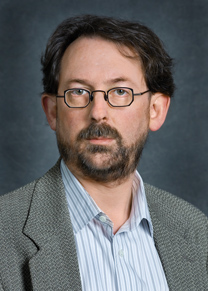
for Structural Bioinformatics Protein Data Bank
Fall
2008
Number 39
| PDB
COMMUNITY FOCUS
Paul D. Adams, Ph.D.,
Q. You have had a long history in the development of crystallographic software. Your latest project is PHENIX–what can you tell us about it? A: At the beginning of this century, the field of structural genomics really took off and it was clear that there would be an increased emphasis on automated crystallographic structure solution. The development of PHENIX was a response to this. A number of us got together, including Randy Read, Tom Terwilliger, Tom Ioerger, and more recently Jane and David Richardson, and decided that it was the right time to do something new. PHENIX has been designed with automation in mind and is based on the Python scripting language. There are tools for automated structure solution using experimental phasing and molecular replacement, structure refinement, ligand coordinate and restraint generation, and structure validation. Although PHENIX has been created with automated structure solution in mind, it is pleasing to see that it is also being used for a number of very challenging structures. PHENIX can be downloaded on the web by academic researchers at www.phenix-online.org. Q. A recent article in Science highlighted the Technology Portal of the PSI SGKB site. What is your vision for this resource? A: Although there is currently much debate about the best future direction for structural genomics research in the US, I think most would agree that this branch of research has generated a large number of tools that are of benefit to all structural biologists. However, one of the problems, not unusual in science, is the communication of these innovations to the scientific community. NIH very wisely decided to put some funding into developing a web-based resource for dissemination of information generated in the US by PSI-funded structural genomics projects. I see this PSI Knowledgebase, lead by Helen Berman, as an essential vehicle for making the broader scientific community aware of these advances. The Technology Portal of the Knowledgebase lets anyone read about new technologies that might be helpful to their own research. Our goal is to provide information so that these researchers can easily get in touch with the technology developers and thus expand the adoption of new technologies. We are also going to set up forums to promote more discussions about technology development in the general scientific community. Q. Most recently, you have taken on a leadership role in the Joint BioEnergy Institute. What are your goals for this organization? A: The long-term availability of fossil fuels and concerns about global warming have made the development of carbon-neutral and renewable sources of energy a priority. The conversion of cellulosic (plant) material to transport fuels has the potential to provide a significant fraction of available fuel in the future. The Joint BioEnergy Institute (JBEI) is one of three Department of Energy (DOE) funded research centers developing the basic science and technology for biofuels production. JBEI is a collaborative effort between Lawrence Berkeley Laboratory, Sandia National Laboratory, Lawrence Livermore Laboratory, UC Berkeley and UC Davis, and the Carnegie Institution at Stanford. We’re located in Emeryville, California, about three miles from UC Berkeley and Lawrence Berkeley Laboratory. There are four Divisions that are addressing different parts of the biofuels problem: Feedstocks, Deconstruction, Fuels Synthesis and Technology. As the Vice President leading the Technology Division, my goal is to create new technologies to support the development of biofuels. In the next five to ten years, JBEI researchers will have developed new feedstocks optimized for biofuels production, new methods to breakdown lignocellulose, and microbes that are optimized for the conversion of sugars to fuels. Q. You have been involved in many aspects of structural biology. Where do you see the future? A: I feel fortunate to have experience in both experimental and computational structural biology–my B.Sc. and Ph.D are in biochemistry but I got involved in crystallography, molecular modeling, molecular dynamics, and parallel computing as a graduate student and postdoc. The field has changed greatly over the last twenty years and I think the future of structural biology is already happening. In the past it was only practical for researchers to specialize in one main experimental technique, such as X-ray crystallography. Now more researchers are embracing the idea that answering a biological problem often requires multiple experimental methods, and that it is feasible to bring these methods in house. I anticipate that many of the ground breaking structural biology research projects in the future will combine multiple biophysical techniques, such as crystallography (X-ray and neutron), electron microscopy, and small angle scattering. Hopefully, the use of computational techniques, such as molecular simulation, will increase as those methods improve. Ultimately new experimental techniques will be developed, such as single particle X-ray diffractive imaging, which will undoubtedly open up new research possibilities. |
E-mail: info@rcsb.org • Web: www.pdb.org • FTP: ftp.wwpdb.org
The RCSB PDB is a member of the wwPDB (www.wwpdb.org)
